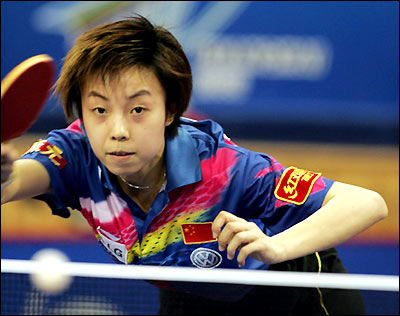In 2004 China made the most remarkable achievements in
competitive sports; Chinese athletes won a total of 106 gold medals
in 27 sports events in Olympic Games, World Championships and World
Cups, of which 53 were Olympic golds in 17 events. At the 28th
Olympic Games, China made its best ever Olympic showing, with a
tally of 63 medals, including 32 gold, 17 silver and 14 bronze,
coming second in the overall medals table and achieving a major
breakthrough in China's sporting history.
 |
Back in March 1959, at the 25th World Table Tennis Championships
held in Germany, the table-tennis player Rong Guotuan won the first
world title in China's sporting history. It was followed by many
more successes. By the end of 2004 Chinese athletes had altogether
won 1,800 world championships and broken 1,119 world records. In
the 16 years since 1989, Chinese athletes have won 1,446 world
championships, accounting for 80.3 percent of the total; and broken
737 world records, making up 65.9 percent of the total. It was a
period when China's competitive sports developed continuously and
rapidly.
At the 2004 Olympics, China took home 63 medals, 36 of them (57.1
percent of the total) being won by young athletes; 10 of the gold
medal winners were under 20 years old. This demonstrates the
increasing maturity of China's young athletes and growing overall
strength in competitive sports.??
At this Olympics, Chinese athletes made outstanding achievements
in tennis, canoeing and track and field. Hurdling star Liu Xiang
became the first Chinese man to win gold in an Olympic track event,
finishing first in the 110-meter hurdles and equaling the world
record of 12.91 seconds. In canoeing Meng Guanliang and Yang Wenjun
won the men's C2 500 final, China's first Olympic gold in aquatic
sports. Sun Tiantian and Liu Ting won the women's tennis doubles
final, China's first ever tennis gold.?
The credit for China's achievements in competitive sports should
go to the training system which is constantly being perfected. It
is based on juvenile amateur sports schools and basic-level clubs,
with teams representing localities as the backbone, and the
national team at the highest level. The training system ensures
that China elite teams maintain a year-round squad of some 20,000
athletes, to become a crack force capable of scaling the world's
sporting heights.?
On February 3, 2004, the State Council proclaimed the Anti-Doping
Regulations, stipulating in detail for the first time regulations
concerning the doping control, anti-doping obligations, doping
examination and monitoring, legal liabilities, etc. The Regulations
have been in force since March 1, 2004.